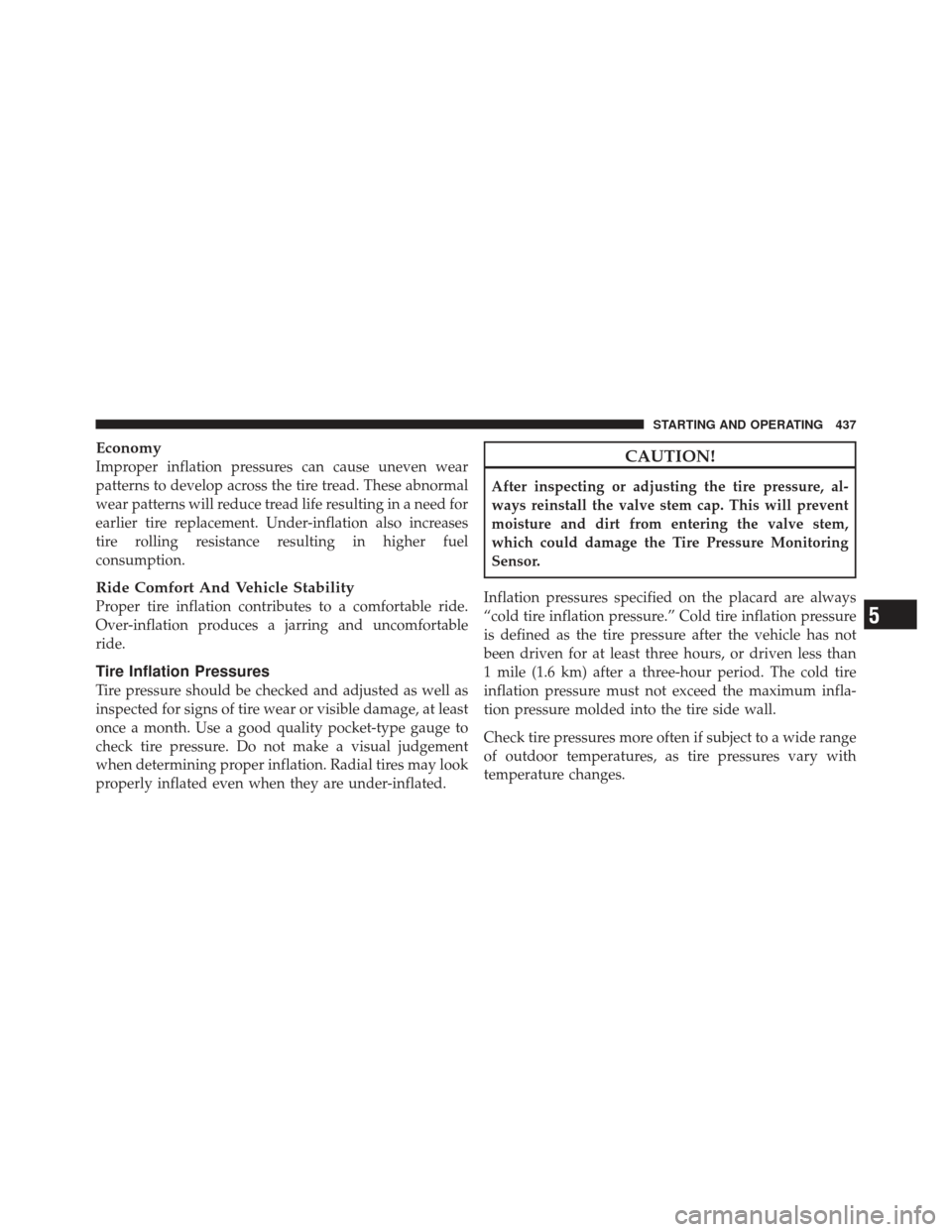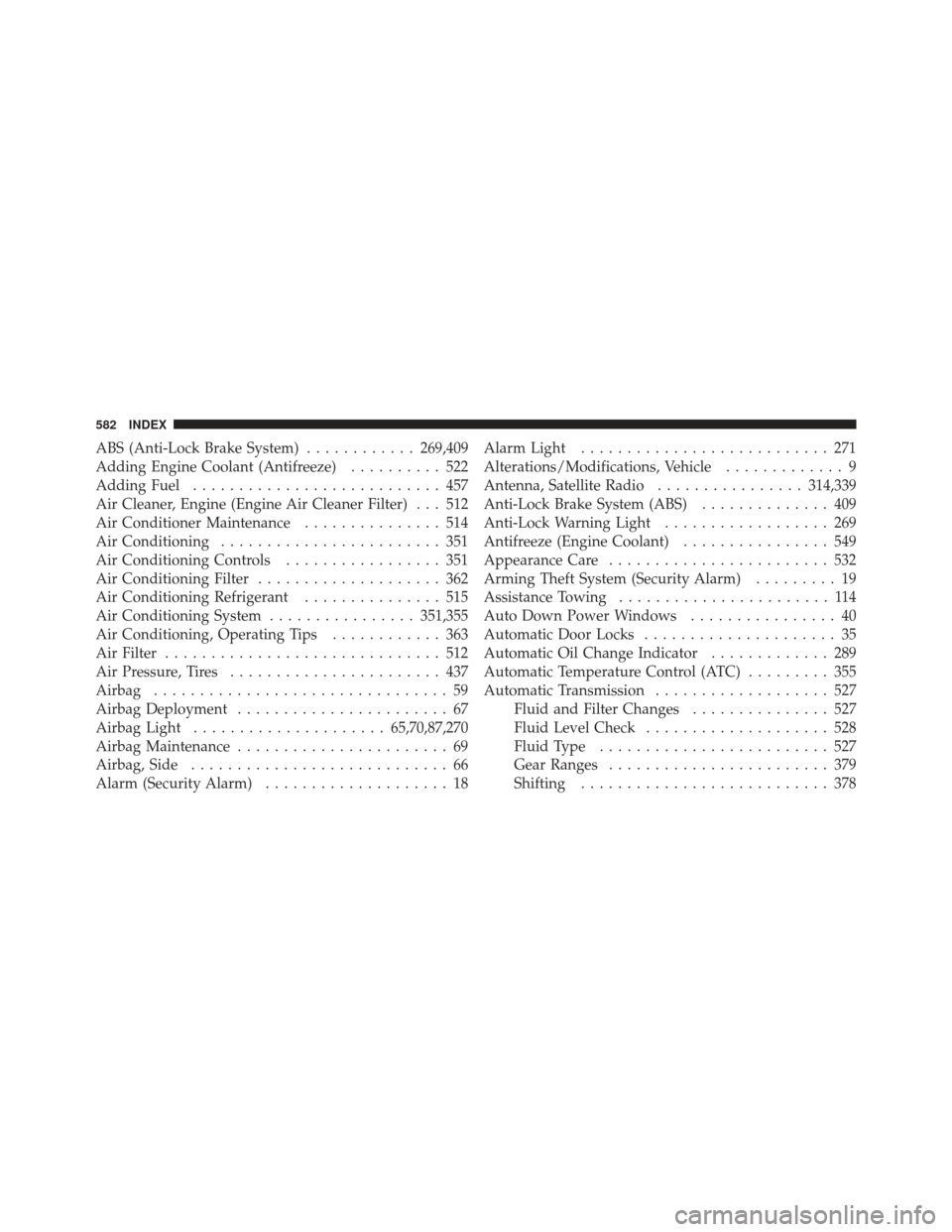fuel type JEEP WRANGLER 2011 JK / 3.G Owners Manual
[x] Cancel search | Manufacturer: JEEP, Model Year: 2011, Model line: WRANGLER, Model: JEEP WRANGLER 2011 JK / 3.GPages: 603, PDF Size: 7.55 MB
Page 276 of 603

tires or wheels on your vehicle, to ensure that the
replacement or alternate tires and wheels allow the TPMS
to continue to function properly.
CAUTION!
The TPMS has been optimized for the original
equipment tires and wheels. TPMS pressures and
warning have been established for the tire size
equipped on your vehicle. Undesirable system opera-
tion or sensor damage may result when using re-
placement equipment that is not of the same size,
type, and/or style. Aftermarket wheels can cause
sensor damage. Do not use tire sealant from a can or
balance beads if your vehicle is equipped with a
TPMS, as damage to the sensors may result.24. Odometer / Trip Odometer Display Area
The odometer display shows the total distance the vehicle
has been driven. The trip odometer shows individual trip
mileage. Refer to “Odometer / Trip Odometer / ECO
(Fuel Saver Indicator) Button” for additional information.
U.S. Federal regulations require that upon transfer of
vehicle ownership, the seller certify to the purchaser the
correct mileage that the vehicle has been driven. If your
odometer needs to be repaired or serviced, the repair
technician should leave the odometer reading the same
as it was before the repair or service. If s/he cannot do so,
then the odometer must be set at zero, and a sticker must
be placed in the door jamb stating what the mileage was
before the repair or service. It is a good idea for you to
make a record of the odometer reading before the repair/
service, so that you can be sure that it is properly reset, or
that the door jamb sticker is accurate if the odometer
must be reset at zero.
274 UNDERSTANDING YOUR INSTRUMENT PANEL
Page 373 of 603

Turn the ignition switch to the START position and
release when the engine starts. If the engine fails to start
within 10 seconds, turn the ignition switch to the LOCK
position, wait 10 to 15 seconds, then repeat the “Normal
Starting” procedure.
Tip Start Feature – Automatic Transmission Only
Turn the ignition switch to the START position and
release it as soon as the starter engages. The starter motor
will continue to run, but will automatically disengage
itself when the engine is running. If the engine fails to
start, the starter will disengage automatically in 10 sec-
onds. If this occurs, turn the ignition switch to the LOCK
position, wait 10 to 15 seconds, then repeat the “Normal
Starting” procedure.
Extreme Cold Weather (Below –20°F Or –29°C)
To ensure reliable starting at these temperatures, use of
an externally-powered electric engine block heater (avail-
able from your authorized dealer) is recommended.
If Engine Fails To Start
WARNING!
•Never pour fuel or other flammable liquids into
the throttle body air inlet opening in an attempt to
start the vehicle. This could result in a flash fire
causing serious personal injury.
•Do not attempt to push or tow your vehicle to get it
started. Vehicles equipped with an automatic trans-
mission cannot be started this way. Unburned fuel
could enter the catalytic converter and, once the
engine has started, ignite and damage the converter
and vehicle. If the vehicle has a discharged battery,
booster cables may be used to obtain a start from a
booster battery or the battery in another vehicle.
This type of start can be dangerous if done improp-
erly. Refer to “Jump Starting” in “What To Do In
Emergencies” for further information.
5
STARTING AND OPERATING 371
Page 439 of 603

Economy
Improper inflation pressures can cause uneven wear
patterns to develop across the tire tread. These abnormal
wear patterns will reduce tread life resulting in a need for
earlier tire replacement. Under-inflation also increases
tire rolling resistance resulting in higher fuel
consumption.
Ride Comfort And Vehicle Stability
Proper tire inflation contributes to a comfortable ride.
Over-inflation produces a jarring and uncomfortable
ride.
Tire Inflation Pressures
Tire pressure should be checked and adjusted as well as
inspected for signs of tire wear or visible damage, at least
once a month. Use a good quality pocket-type gauge to
check tire pressure. Do not make a visual judgement
when determining proper inflation. Radial tires may look
properly inflated even when they are under-inflated.
CAUTION!
After inspecting or adjusting the tire pressure, al-
ways reinstall the valve stem cap. This will prevent
moisture and dirt from entering the valve stem,
which could damage the Tire Pressure Monitoring
Sensor.
Inflation pressures specified on the placard are always
“cold tire inflation pressure.” Cold tire inflation pressure
is defined as the tire pressure after the vehicle has not
been driven for at least three hours, or driven less than
1 mile (1.6 km) after a three-hour period. The cold tire
inflation pressure must not exceed the maximum infla-
tion pressure molded into the tire side wall.
Check tire pressures more often if subject to a wide range
of outdoor temperatures, as tire pressures vary with
temperature changes.
5
STARTING AND OPERATING 437
Page 513 of 603

Engine Oil Selection
For best performance and maximum protection for all
engines under all types of operating conditions, the
manufacturer recommends engine oils that are API Cer-
tified and meet the requirements of Chrysler Material
Standard MS-6395.
American Petroleum Institute (API) Engine Oil
Identification Symbol
This symbol means that the oil has
been certified by the American
Petroleum Institute (API). The
manufacturer only recommends
API Certified engine oils.
CAUTION!
Do not use chemical flushes in your engine oil as the
chemicals can damage your engine. Such damage is
not covered by the New Vehicle Limited Warranty.
Engine Oil Viscosity (SAE Grade)
SAE 5W-20 engine oil is recommended for all operating
temperatures. This engine oil improves low temperature
starting and vehicle fuel economy.
The engine oil filler cap also shows the recommended
engine oil viscosity for your engine. For information on
engine oil filler cap location, refer to “Engine Compart-
ment” in “Maintaining Your Vehicle” for further informa-
tion.
Lubricants which do not have both, the engine oil certi-
fication mark and the correct SAE viscosity grade num-
ber, should not be used.
7
MAINTAINING YOUR VEHICLE 511
Page 584 of 603

ABS (Anti-Lock Brake System)............269,409
Adding Engine Coolant (Antifreeze) .......... 522
Adding Fuel ........................... 457
Air Cleaner, Engine (Engine Air Cleaner Filter) . . . 512
Air Conditioner Maintenance ............... 514
Air Conditioning ........................ 351
Air Conditioning Controls ................. 351
Air Conditioning Filter .................... 362
Air Conditioning Refrigerant ............... 515
Air Conditioning System ................351,355
Air Conditioning, Operating Tips ............ 363
Air Filter .............................. 512
Air Pressure, Tires ....................... 437
Airbag ................................ 59
Airbag Deployment ....................... 67
Airbag Light ..................... 65,70,87,270
Airbag Maintenance ....................... 69
Airbag, Side ............................ 66
Alarm (Security Alarm) .................... 18 Alarm Light
........................... 271
Alterations/Modifications, Vehicle ............. 9
Antenna, Satellite Radio ................314,339
Anti-Lock Brake System (ABS) .............. 409
Anti-Lock Warning Light .................. 269
Antifreeze (Engine Coolant) ................ 549
Appearance Care ........................ 532
Arming Theft System (Security Alarm) ......... 19
Assistance Towing ....................... 114
Auto Down Power Windows ................ 40
Automatic Door Locks ..................... 35
Automatic Oil Change Indicator ............. 289
Automatic Temperature Control (ATC) ......... 355
Automatic Transmission ................... 527
Fluid and Filter Changes ............... 527
Fluid Level Check .................... 528
Fluid Type ......................... 527
Gear Ranges ........................ 379
Shifting ........................... 378
582 INDEX